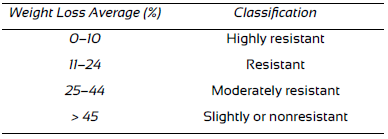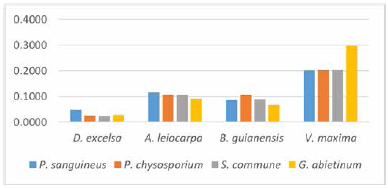Introduction
In 2014, round wood production in Brazil decreased by 3.2%, particularly in the states of Pará, Mato Grosso, and Rondônia, which together accounted for 73.8% of the national production (Instituto Brasileiro de Geografia e Estatística, 2016). The wood produced in Brazil fulfills a wide range of purposes, including applications in the pulp and paper industry, for furniture, wood-based panels’ production, and in civil construction. Based on this information, in 2013, the Brazilian National Standards Organization (ABNT) published the norm NBR- 15575:2013, which established technical parameters and standards in building, improving the quality of the products industrially manufactured and creating specifications to guarantee increased safety and comfort.
Natural biodegradation of wood, which directly influences the safety of these products, can be examined using different techniques. These techniques are frequently used in wood-based panel studies, such as those performed by Mendes et al. (2014) on Pinus taeda, Mendes, Bortoletto Júnior, Garlet, De Almeida and Surdi, (2013) on Acacia mangium and Gonçalves, Brocco, Paes, Loiola and Lelis (2014) on oriented strand board (OSB) panels of P. taeda.
In products based on sawn timber from Amazon woods, these tests are scarcely performed because the natural density and durability of the wood is high; however, the woods have stains that indicate the start of biodegradation. Biodegradation begins with the spread of microorganisms on the surface of the wood, resulting in changes certain properties of the wood such as color or aesthetics (Sudár et al., 2013).
According to Kirk and Cullen (1998), wood-decay fungi can be classified into three groups: white rot fungi, which can degrade the three components of the plant cell wall (cellulose, hemicellulose, and lignin); brown rot fungi, which can degrade the polysaccharide fractions (cellulose and hemicellulose); and soft rot fungi, which can slowly degrade both the polysaccharide fractions and the lignin.
Therefore, it is of utmost importance to assess Amazon wood species since this will contribute to a wider knowledge on the subject and avoid potential loss and damages derived from the replacement of deteriorated woods.
Objectives
The objective of the present study aimed to assess the natural resistance of four Amazon tropical wood species used in the production of sawn timber, against infection with xylophagous fungi.
Materials and methods
Local and selected species
The study was conducted in the Technology Laboratory at the Forest Engineering Faculty - Federal University of Pará. The assay was performed according to ASTM D2017-86 (American Society for Testing Materials [ASTM], 2005), with the following alterations:
The test wood specimens were prepared to the following dimensions: 2 cm × 2 cm × 2 cm.
The fungus was cultured in liquid media containing malt and distilled water.
A survey was conducted on the main timber companies and site offices in the municipality of Altamira-PA to identify the most-used species in sawn timber production; thus, four wood species were selected (Table 1). To confirm whether the samples collected belonged to the reported species, the samples were identified macroscopically with the aid of a magnifier and compared with the collection at the Technology Laboratory of the Federal University of Pará.
A total of 192 samples that were free of any type of defect such as wood knots, fissures, and cracks were prepared. The specimens were then sanded with sandpaper grit size no. 200 and 12 specimens were selected for each fungal species. Subsequently, each side of the sample (tangential, radial, and transverse) was identified with a number using a waterproof ink pen. In addition, 12 samples each were prepared for Pinus sp. And Cecropia sp., which were used as reference woods according to the norm.
Moisture content in the test specimens was monitored in a group of five samples, which were representative of each wood species. First, the wet weight of the samples was obtained; subsequently, the samples were incubated at 103 °C ± 2 °C until the weight of the samples was constant. Thus, it was possible to calculate the moisture content of the material analyzed.
Four species of wood-decay fungi were used, including three white rot fungi and one brown rot fungus, obtained from pure cultures of the Department of Plant Pathology, Federal University of Lavras, which were codified with specific names as described in Table 2.
Decay assay
The assay was performed at the Plant Pathology Laboratory in the Faculty of Agronomy Engineering of the Universidade Federal do Pará. We used 250-mL flasks (clear glass) with screw caps, containing 70 g of soil (red latosol), free of organic matter. Limestone had been previously added to the soil to raise the pH to 6.0.
A support plate of 2.5 cm × 2.5 cm × 0.5 cm was placed in each flask to allow the initial growth of the fungus. Support plates of pinus (Pinus sp.) were used for the cultivation of G. abietinum, and plates of embauba (Cecropia sp.) were used for the cultivation of P. sanguineus, Phanerochaete chrysosporium, and Schizophyllum commune fungi. The flasks were autoclaved at 121°C for 45 min. Then, each flask was inoculated with 3 mL of malt liquid media containing fragmented mycelia, which was directly placed over the support plate.
After inoculation, the flasks were placed in an incubator at 27 °C until the mycelium completely covered the support plate (2 weeks).
Air conditioning and sterilization of the test specimens
The test specimens were acclimatized in an incubator at 50 °C ± 1 °C for 24 h, so that all results could be obtained under the same conditions. After air conditioning, the specimens were placed in a desiccator containing silica for approximately 10 min and were then weighed. Before the inoculation, the specimens were sterilized in an autoclave at 121 ºC for 1 h.
Inoculation, period of fungal attack, and removal of test specimens
The specimens were introduced aseptically to the flasks containing the fungus with the aid of tweezers. Three samples were added to each flask and maintained for 2 weeks. After the fungal attack period, the specimens were removed from the flasks and gently cleaned with a brush to remove mycelia that had accumulated on the surface of the samples. Thereafter, the specimens were acclimatized in an incubator at 50 °C ± 1 °C for 24 h and weighed to obtain the final weight after the period of fungal infection.
Assessment of weight loss
After the 12-week period, the degree of natural resistance of each wood specimen was assessed according to its weight loss.
Thus, we obtained the average weight loss values for the species under study and for the reference wood species Pinus sp. And Cecropia sp., to further assess the intensity of biodegradation.
The classification of the natural resistance of wood species was determined according to the norm ASTM D 2017 (Table 3).
Statistical analyses
The results obtained regarding the weight loss of the wood specimens, expressed in percentage, were statistically analyzed. For the assessment, we used the factorial analysis of variance in a completely randomized experiment with two factors: fungi and wood species, with each of the factors having four levels. For each combination of fungus × wood species, 12 completely randomized repetitions were performed. For multiple comparison of the means, Tukey’s test was used at 5% probability.
Results and discussion
Wood-decay fungi attack
Faster growth and development was observed in the mycelia of the white rot fungi, with Schizophyllum commune (PD21) showing a greater development than the other species examined. On the other hand, G. abietinum (PD63) exhibited growth and rest periods, demonstrating overall slow growth (Fig. 1).
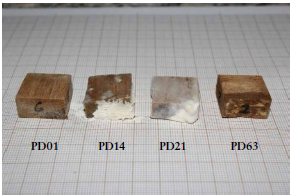
Figure 1 Mycelial growth of Pycnoporus sanguineus (PD01), Phanerochaete chrysosporium (PD14), Schizophyllum commune (PD21) and Gloeophyllum abietinum (PD63) fungi, respectively.
When analyzing the behavior of P. sanguineus and Gloeophyllum trabeum, Alves et al. (2006) observed faster development of P. sanguineus when compared with G. trabeum in six Amazon woods under study. Eaton and Hale (1993) reported that G. trabeum showed a slower development when compared to white rot fungi.
According to Carvalho, Canilha, Ferraz and Milagres (2009), the white rot fungi are considered more efficient at wood biodegradation, since they are able to break down the three components of the plant cell wall (cellulose, hemicellulose, and lignin), whereas the brown rot fungi mainly degrade the polysaccharide fractions (cellulose and hemicellulose).
Eaton and Hale (1993) argued that the natural resistance of wood is dependent on the access routes available to fungi and the chemical composition of the wood, with the latter being a characteristic that varies substantially among species and within the same tree.
When analyzing the classification, all species in this study were considered highly resistant. Stangerlin, Da Costa, Garlet and Pastore (2013) reported that the attack period of rot fungi, as described by the norm ASTM D2017, is not sufficient to be applied to the Amazon woods, which suggests that this parameter of the norm should be revised for tropical woods.
Table 4 shows the average weight loss in grams and as a percentage, together with the classification of natural resistance according to the norm ASTM D2017/86 of the four wood species, after exposure to attack by fungi PD01, PD14, PD21, and PD63.
Table 4 Mean values of weight loss and classification of natural resistance in woods submitted to attack by Pycnoporus sanguineus (PD01), Phanerochaete chrysosporium (PD14), Schizophyllum commune (PD21) and Gloeophyllum abietinum (PD63) fungi.
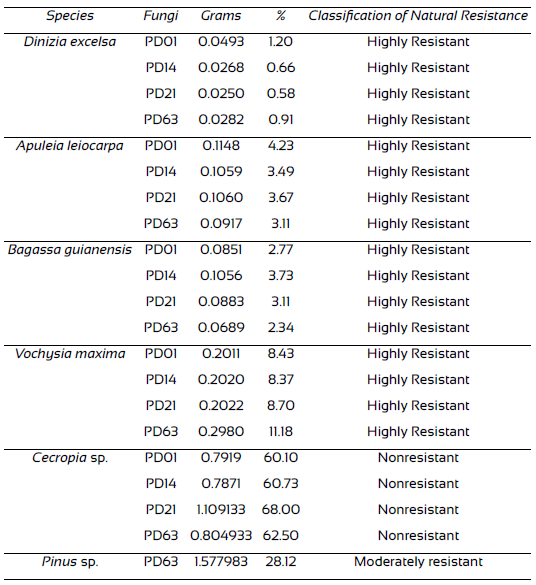
The species D. excelsa showed lower weight loss than did the remaining wood species. This was also observed among all the fungi tested, with the fungus P. sanguineus causing greater weight loss (1.20%) than the other fungi tested.
Alves et al. (2006) examined Peltogyne paniculata (purpleheart wood) and found that the fungi Pycnoporus sanguineus presented the lowest weight loss (4.88%) among the various fungal species analyzed in their study.
Analysis of A. leiocarpa and B. guianensis showed that these species lost similar amounts of weight for all the tested fungi, which was around 3%.
In contrast, V. máxima showed a higher percentage of weight loss with an average of 9.17% for all the fungi assessed. This could have occurred due to the low specific mass together with the type of parenchyma found in the species. According to Silva (2005), woods that are most resistant to the action of these organisms are those that have high specific mass, since they have a denser structure with a high content of substances such as tannins and lignin impregnating their cell walls. According to the same author, the abundance of parenchymal tissue provides low natural durability.
De Nadai, Castelo, Stargerlin and Magistrali (2013) reported that specific mass is not the main factor that provides natural durability to wood; however, this can be attributed to factors such as the content and type of extractives. Thus, it is necessary to analyze the wood extractives content to obtain more accurate data.
In contrast, among the reference woods used, the fungus G. abietinum did not have high ability for biodegradation in the pinus species, as the norm requires that the control species, Pinus sp. and Cecropia sp., should have weight loss greater than 50% in order to prove the fungus vigor. Nevertheless, the remaining white rot fungi showed good development, with an average of 62.83% for Cecropia sp.
Mendes et al. (2014) observed a weight loss in the reference woods of 50.76% in the cecropia wood caused by the fungus Trametes versicolor and of 53.33% in the pinus wood caused by the fungus G. trabeum.
Carneiro, Emmert, Sternadt, Mendes and Almeida (2009) reported an average weight loss of 0.60% when B. guianensis was tested. This value is well below those found in the present study for this wood species, which had a weight loss average of approximately 3% for the four fungi tested.
We observed that V. máxima showed the greatest weight loss for all the fungi tested, with the brown rot fungus contributing more to the weight loss as shown in Figure 2. This might be because this wood showed higher porosity, thus facilitating fungus penetration.
Lepage (1986) explained that, in general, brown rot causes a decrease in the physical characteristics of wood faster than does white rot. There was no difference between the averages of the fungi analyzed (Table 5); however, the averages of all the wood species tested were significant, with the results demonstrating that the intensity of the fungal attack is associated with the wood species under attack.
Table 5 Comparison of weight loss averages of the species submitted to attack by fungi using Tukey’s test.
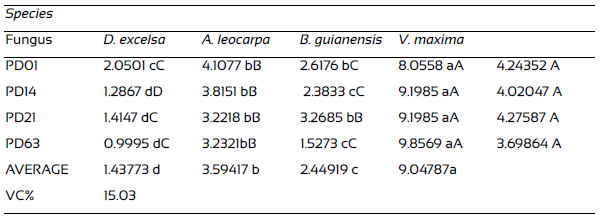
Means followed by the same capital letter in the rows and lowercase in the columns do not differ by Tukey’s test at 5% probability.
Weight loss in D. excelsa, A. leiocarpa, and B. guianensis were not statistically different; however, D. excelsa had the lowest average weight loss when compared with the remaining species.
When comparing the results obtained in an experiment with wood of different resistance classes exposed to xylophagous fungi. When attacked by the white rot fungus Pycnoporus sanguineus, the heartwood showed a weight loss lower than 10%, and could be classified as resistant. However, V. máxima showed a higher weight loss, demonstrating that it had lower resistance to the fungi tested.
In another study, Labat et al. (2000) studied Erisma uncinatum, which belongs to the same family as V. maxima, and they observed a weight loss of up to 0.3% following an incubation period of 6 weeks with the fungus G. trabeum.
Conclusions
All four tested woods were found to be highly resistant to fungi. The Woods D. excelsa, A. leiocarpa and B. guianensis showed lower weight loss, whereas V. máxima showed the highest weight loss, which demonstrated that woods presenting greater density were the most resistant to rot caused by the fungi. We recommend that the D. excelsa, A. leiocarpa and B. guianensis be used for sawn timber production.











 nueva página del texto (beta)
nueva página del texto (beta)



